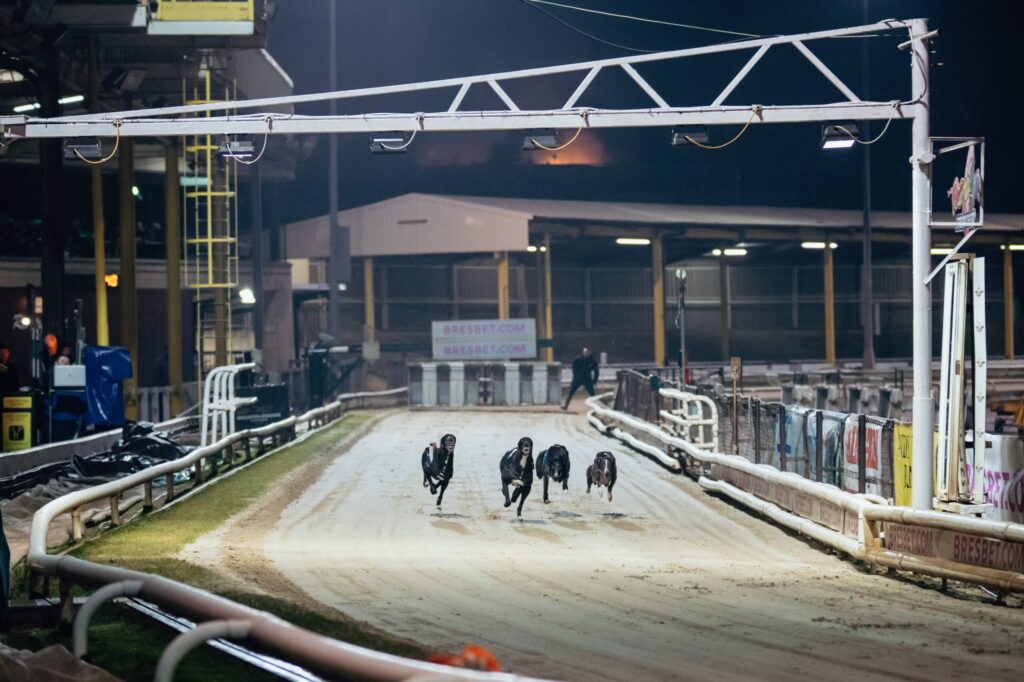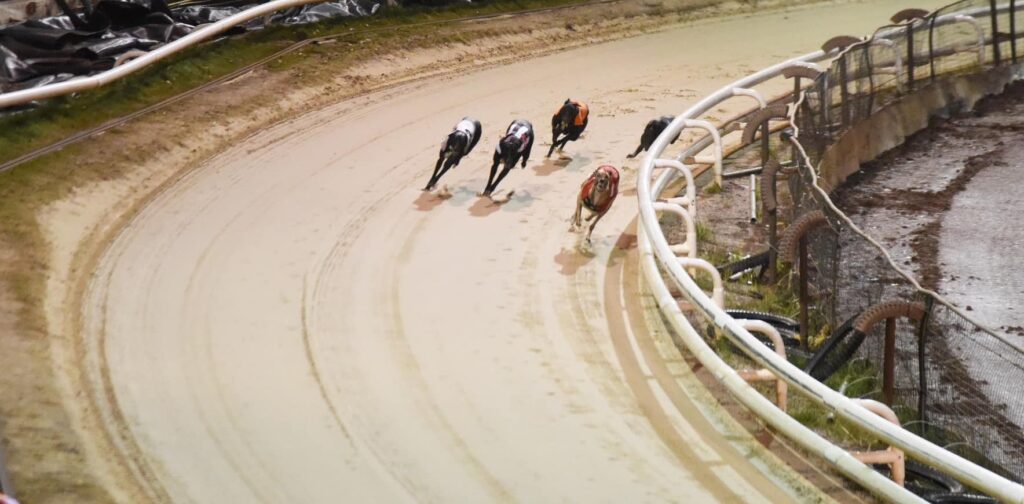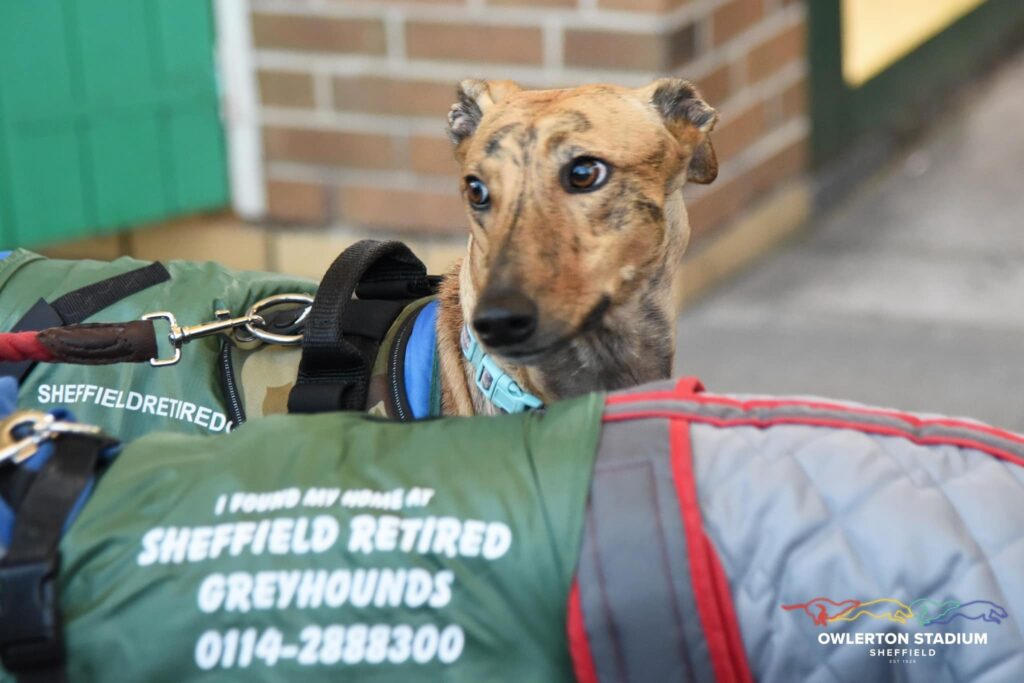Table of Contents
If you’re a newcomer to greyhound racing or a seasoned fan who isn’t up to speed with the basics, we’ve compiled everything you need to know about the sport from racing categories to greyhound hurdle racing.
At first, live greyhound racing may just seem like dogs chasing a mechanical hare, but let’s dive into all the technical key factors that go on behind the scenes!

Greyhound Racing Styles
Did you know there are different styles of greyhound racing? Each brings a unique edge and added enjoyment to the track. Some tracks around the world showcase hurdle racing, although at Owlerton Stadium we are a flat racing stadium:
Flat Racing
You’ve guessed it! As it says in the name, flat racing is a smooth race without any hurdles or steeples – testing the dogs’ speed, endurance, and agility. Across the UK, greyhounds commonly race around an oval flat track, however on some occasions you might catch a straight race.
Decoding a Greyhound Racecard
A greyhound racecard is your go-to for information on race day, with all the handy details on the dogs’ statistics, previous races, and everything else you’ll need to know. Alongside the greyhounds’ names, ages, sex, and weights, the racecard highlights things you might need to note about the race itself – including distance, grade/class, start time, and race number.
For those looking for a higher tote return, they consider all of the above factors before placing their bet!
Greyhound Competitions & Events
Each week greyhound venues across the UK host their local competitions, but throughout the year The Greyhound Board of Great Britain unveil an annual lineup of nationwide events!
English Greyhound Derby
The English Greyhound Derby is the premier event in British Greyhound racing, boasting a history that dates back to 1927. Originally hosted at White City Stadium, the race has since moved around to Wimbledon, Nottingham and now Towcester.
Smaller Prominent Events
Running throughout the year across the UK, including at Owlerton Stadium, there’s plenty going on in the greyhound racing scene – such as BresBet Steel City Cup and BGBF British Bred Derby. These usually showcase higher prize money and various race categories/classes.
Racing Categories & Classes
Open Races
Open events welcome all greyhounds but are typically geared towards higher-class competitors. These races often feature more experienced dogs with impressive track records and offer larger prize purses. The competitive nature of open events attracts the top greyhounds, making these races more intense and prestigious.
Handicap Racing
Handicap races are a unique type of greyhound racing where dogs of varying abilities are given different starting positions. The Racing Manager uses this system to level the playing field, giving slower greyhounds a head start to enhance competition and create a more balanced and exciting race.
A1 to A11 Grades
The most popular ‘A’ category represents a wide range of greyhound grades, starting from A1 (the best) to A11 (the slower dogs). The eleven division types allow for fair competition structuring.
Puppy
Grade P (puppy) is for dogs aged between 15 and 24 months, providing a great opportunity to watch emerging talent before they advance to more seasoned races.
Maiden
Maiden races are for greyhounds that are still seeking their first victory. These events are crucial for younger or less experienced dogs to start their racing careers.

Key Factors in Greyhound Racing
Training Routines and Techniques
When Trainers are working with their greyhounds, their methods focus on conditioning, skill development, and injury prevention. Much like human exercises, greyhounds work through long runs, hill runs, speed trials, warm-ups and cool-downs, hydration, and balanced diets.
To develop their mental training, greyhounds are exposed to different environments, sounds, and positive reinforcement to build confidence and get used to a range of situations. Routine veterinary check-ups ensure that greyhounds are in good health and can compete safely.
Track Surfaces
In greyhound racing, track surfaces can significantly affect the performance of the dogs. In the UK all stadiums run on sand, however, there are other materials across the globe:
- Sand: Provides good traction for the greyhounds, reducing the risk of slipping and allowing for high-speed performance.
- Synthetic: Provides a very consistent surface, which can be beneficial for predicting race outcomes and maintaining fair conditions. Rubber and other substances are used which mimic a natural surface.
- Grass: Grass would be difficult to use in the UK due to frequent rain which can cause grass to become slippery and affect race conditions.
Worldwide Differences
Greyhound racing varies significantly around the world due to differences in regulations, track types, cultural attitudes, and the level of popularity.
Nowadays, it seems greyhound racing is quite a niche interest in countries other than the UK, Australia, and America – Which still have governed associations and marquee events. Interestingly, American tracks are known for preferring grass tracks or even dirt tracks in rural Mexico!
Although the British greyhound is the dominant breed, some countries like Spain, Russia, and Italy have their own breeds – Did you know there’s even an Italian greyhound miniature?
Now that you’re proficient in all things greyhound racing, start planning your next visit to Owlerton Stadium, Sheffield, and put your new knowledge to the test!

Regulatory Standards & Guidelines
Certain guidelines and rules govern the conduct of open races. These rules ensure fair competition, promote greyhound welfare and maintain the integrity of the sport. Key guidelines include:
Health and Safety of Dogs
Ensuring the physical well-being of the competing dogs is of paramount importance.
Strict Adherence to Race Rules
All participants, including trainers and owners, must strictly adhere to the established rules of the sport.
Regular Doping Tests
Random drug testing is implemented to prevent any use of performance-enhancing substances.
Frequently Asked Questions
What happens to retired racing greyhounds?
Retired racing greyhounds typically undergo one of the following processes:
Adoption: Numerous organisations specialise in rescuing and rehoming retired greyhounds, placing them in loving forever homes.
Staying with trainer or owner: In some cases, retired greyhounds stay with their trainers or owners for the remainder of their lives.
What are some of the safety measures in place to protect greyhounds during a race?
Greyhound racing tracks implement various safety measures to minimise the risk of injury to the dogs, including:
Track maintenance: Regular maintenance ensures that the track surface remains in optimal condition, reducing the risk of accidents caused by uneven surfaces or debris.
Starting boxes: Starting boxes are designed to protect greyhounds from injury during the initial launch of the race by providing a separate space for each dog, reducing the chances of dogs colliding.
Muzzle and racing blankets: Dogs wear muzzles to protect them and their competitors from potential bite-related injuries. In addition, racing blankets help spectators and officials quickly identify each dog during the race.
Veterinary care: Veterinarians are present on-site during races to monitor the dogs’ health and respond to any injuries that may occur during the race.


